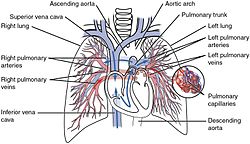
Back الدورة الدموية الصغرى Arabic Plućna cirkulacija BS Circulació pulmonar Catalan سییەسووڕ CKB Plicní oběh Czech Lungenkreislauf German Circulación pulmonar Spanish Väike vereringe Estonian گردش خون ششی Persian Pieni verenkierto Finnish
| Pulmonary circulation | |
|---|---|
 Pulmonary circulation in the heart | |
| Details | |
| System | Circulatory system |
| Identifiers | |
| MeSH | D011652 |
| Anatomical terminology | |
The pulmonary circulation is a division of the circulatory system in all vertebrates. The circuit begins with deoxygenated blood returned from the body to the right atrium of the heart where it is pumped out from the right ventricle to the lungs. In the lungs the blood is oxygenated and returned to the left atrium to complete the circuit.[1]
The other division of the circulatory system is the systemic circulation that begins with receiving the oxygenated blood from the pulmonary circulation into the left atrium. From the atrium the oxygenated blood enters the left ventricle where it is pumped out to the rest of the body, returning as deoxygenated blood back to the pulmonary circulation.
The blood vessels of the pulmonary circulation are the pulmonary arteries and the pulmonary veins.
A separate circulatory circuit known as the bronchial circulation supplies oxygenated blood to the tissue of the larger airways of the lung.
- ^ Hine R (2008). A dictionary of biology (6th ed.). Oxford: Oxford University Press. p. 540. ISBN 978-0-19-920462-5.